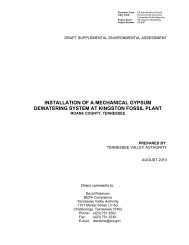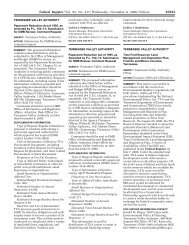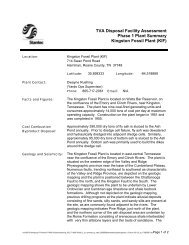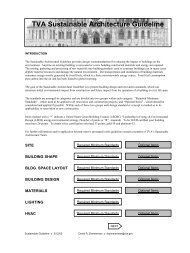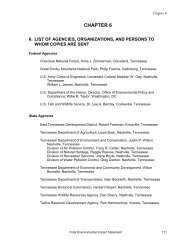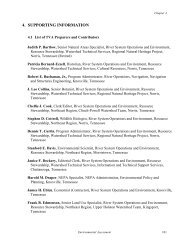Corrective Action Plan - Tennessee Valley Authority
Corrective Action Plan - Tennessee Valley Authority
Corrective Action Plan - Tennessee Valley Authority
Create successful ePaper yourself
Turn your PDF publications into a flip-book with our unique Google optimized e-Paper software.
Kingston Ash Release March 2009<br />
<strong>Corrective</strong> <strong>Action</strong> <strong>Plan</strong><br />
the AAMP will aid in identifying potentially adverse off site impacts, so that these conditions can<br />
be remedied as necessary.<br />
This monitoring plan may be augmented for task-specific activities, as appropriate. For<br />
instance, if a type of dust suppression agent is used on the ash, air samples from closer<br />
locations may be collected for additional analysis to determine the efficacy of the chosen agent.<br />
3.1.2 GROUNDWATER<br />
As discussed in greater detail in Section 4 of this CAP, monitoring of groundwater from both<br />
onsite and offsite locations has been an ongoing activity since the initial ash spill in order to<br />
determine affects on localized groundwater resources and public health. This routine<br />
monitoring will continue and a SAP will be developed to support this work.<br />
In support of task specific cleanup activities or design requirements, focused DQO sessions will<br />
be completed which will establish task specific groundwater sampling approaches and<br />
subsequent SAPs to support these activities. These plans may include the installation of<br />
additional groundwater monitoring and observational systems to supplement existing monitoring<br />
networks. The content of the plans will depend on the type and location of planned remedial<br />
activities.<br />
Groundwater well abandonment plans and procedures may also be developed in order to<br />
support activities associated with the well abandonment for KIF wells damaged during the initial<br />
event or wells deemed as no longer required as part of future monitoring. Groundwater well<br />
abandonment plans will be developed in accordance with applicable state requirements.<br />
3.1.3 SURFACE WATER<br />
Initial water quality monitoring began December 22, 2008 and was focused on evaluating the<br />
extent of water quality affects associated with the ash spill. Variables monitored focused on<br />
total suspended solids and heavy metals, as these variables were determined to be most likely<br />
to be elevated by a spill of this type. One focus of the early monitoring was to determine<br />
whether there had been any effect on public drinking water supplies. Samples of river water<br />
were collected in close proximity to the Kingston Water Treatment <strong>Plan</strong> (KWTP) intake near<br />
TRM 568. Subsequently, following a few days of TVA monitoring of river water and finished<br />
drinking water quality at that plant, a program was developed in which TDEC obtained samples<br />
of both raw and finished water, ultimately at the four water utilities in closest proximity to the<br />
spill, and had them analyzed by the <strong>Tennessee</strong> Department of Health Environmental<br />
Laboratory. It is expected that this routine monitoring of public water supply intakes and<br />
finished water will continue throughout the ash cleanup effort.<br />
In support of both routine and task specific activities, TVA will continue its monitoring of surface<br />
water three times per week at five locations on the Emory River, four locations on the Clinch<br />
River, and two locations on the <strong>Tennessee</strong> River during dredging operation (Table 3.1). These<br />
designated surface water monitoring sites will also be sampled after every 0.5” or greater (24-<br />
hour total) rain event as monitored at the onsite TVA mobile lab and the meteorological station<br />
co-located with an air monitoring station on Lakeshore Drive. This plan will be amended or<br />
updated, as required, as various remedial actions are planned. Additional in-situ stream<br />
measurements such as turbidity monitoring could be conducted as specified in the plans.<br />
Implementation of a long-term sampling plan for surface water will continue throughout the<br />
recovery and remediation process to ensure that any threat to public health is quickly detected.<br />
3-2





